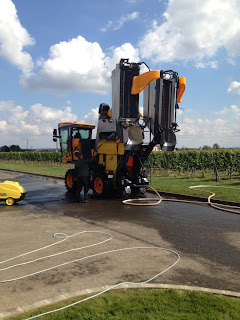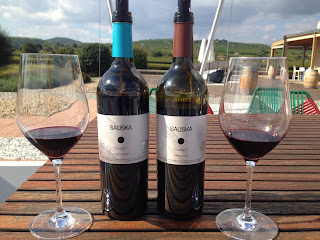(117 wines tasted through the end of this post)
Villany
is pronounced vee-lah-nee, with the accent on lah. However you pronounce it, it is lovely. I think it could be transported to a rural
French countryside and fit right in with its neighboring villages. One bank.
One grocery store. What seems
like fifty or more small wine ‘pinces’ lined up on either side of part of the
main thoroughfare.
Even
the plantings in the village suggest France.
Look at the lavender and rosemary.
My
last day here is devoted to two things.
One is a trip to the Sauska winery for a tasting. The other is to eat an outrageously delicious
last meal at the Bock Ermitage. The
reason I have picked out Sauska is that their wines are featured prominently on
the wine list of two of the Michelin starred restaurants in Budapest.
The
Sauska winery is situated about a half mile outside the village proper. It is a walk of a little over a mile from my
hotel. (I wish I had packed a pedometer for this trip.) As I leave the village,
the scenery becomes one of vineyards on my right. I walk past Gere winery, well known in the
region.
Next come the Sauska
vineyards. Their grape vines are
planted to within several feet of the sidewalk.
As
I walk onto the Sauska property, I see an automatic grape picking machine being
washed down. These machines were getting
popular in Argentina at the end of our vineyard ownership there. Labor was becoming a real issue, especially
the part about agreeing on a price for picking.
The foreman would show up with a busload of pickers and then proceed to
re-negotiate the formerly agreed upon price. Not much fun.
I
walked up a flight of stairs and onto the tasting terrace where I was met by
Christian Csermak. I had emailed
Christian the previous day requesting a tasting. Fortunately he spoke English well. The terrace sits on top of a portion of the
winery’s building off to one side. It
affords a marvelous view of the surrounding vineyards. The sky was filled with puffy clouds against
a robin’s egg blue sky. An intermittent
breeze imparted a chill to the air whenever the sun hid behind a cloud.
Christain
and I began with a discussion of viniculture in Hungary and the flavors of wine
from different regions. He gave me a
moment to look over the extensive tasting menu, and we started with a rose.
Villany rose 2015
This is one of the wines on Onyx’s wine list (a restaurant in
Budapest with a Michelin star).
The wine is a blend of six varietals - Kekfrankos, Merlot. Cabernet franc, Cabernet Sauvignon,
Syrah, and Pinot noir. It boasts a
lovely color and a light fresh fruit flavor.
I like chardonnay’s, especially oaked ones. That was the second wine to taste.
Chardonnay 2009
This wine came with an interesting explanation. In 2009 most of the oak in this winery was
new, and wineries were experimenting with how much time to leave the wine in
oak. It was also when Sauska adopted the
practice of chardonnay harvesting from California, where the chardonnay grapes
were harvested at night for two reasons.
One was that the grape was at a much cooler temperature; the other had
to do with the texture of the grape skin.
This chardonnay had little bouquet. The flavor at the finish was one of strong
toasted oak.
The next wine was a Siller.
This was a first for me (later to be repeated in Szekzard). It is a ‘relative’ of a rose. Aside from the flavor being a bit different
from the rose, it is also darker in color which comes from the grape skins
being left intact with the juice for a longer period than that of a rose.
This wine had a sour cherry bouquet and slight sour cherry flavor
as well. A very nice wine.
Next, I tasted a series of cuvees. To refresh your memory, a cuvee here simply
means a blend of wines.
Cuvee 11, 2012
Lovely Cabernet franc nose
Flavor of the Cabernet fading to dry
Slightly resinous
Cuvee 13
Lighter, fresher wine with more of the flavor of the grapes
Dry finish
Younger fresher wine, definite note of Syrah in the bouquet
Then came an interesting dilemma. Taste the Cuvee 7 from the vineyards of the
neighboring village, Siklos, or the Cuvee 7 from the vineyards of Villany? The answer turned out to be simple. Taste both.
Cuvee 7 Siklos
Merlot bouquet
Ascerbic, dry
Chewy
Cuvee 7 Villany
Dry, lightly medicinal
Not much flavor
Fades quickly
Dry finish
The
final wine of the day was a merlot. How
many merlots are there matured in oak? I
can’t remember tasting one. (Perhaps my dear departed friend Ed, a merlot
aficionado, would have tasted them.) This one spent a lot of time in oak
barrels.
The
bouquet said merlot. The flavor said
merlot. And the finish yelled OAK!
I
had arrived on Sauska’s tasting terrace a little after noon. As I walked down the steps to head back to
the hotel, I looked at my watch. I had
spent a little over four hours enjoying the wines, scenery, and knowledge I had
gained from my discussions with Christian, who patiently explained each wine
and responded to my many questions about viniculture in the Villany region.
I
have taken up too much of your time already in this post. I’ll cover my farewell dinner at the Bock
Ermitage Hotel in my next post.









No comments:
Post a Comment